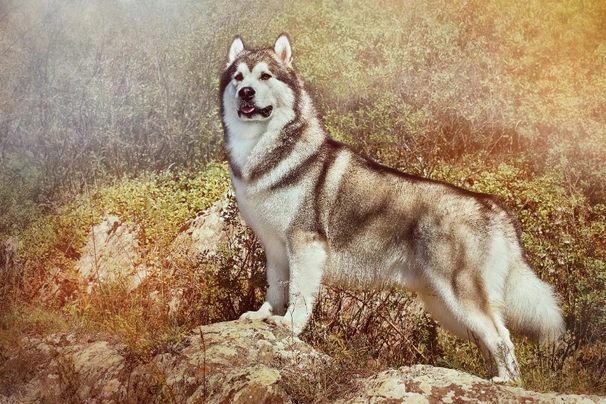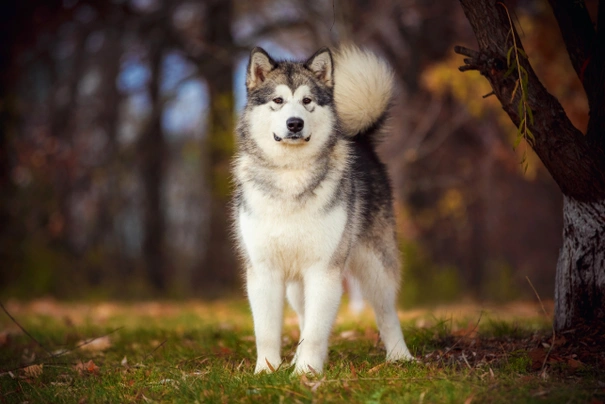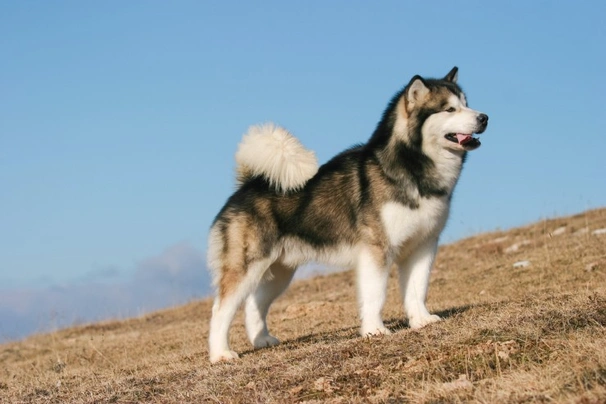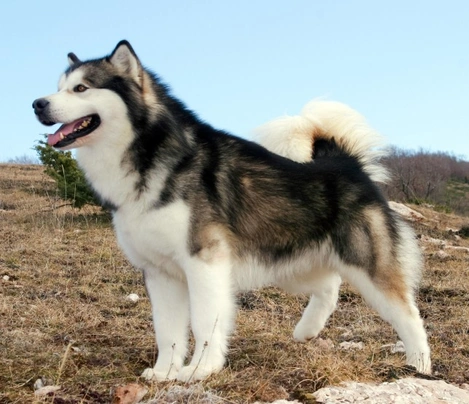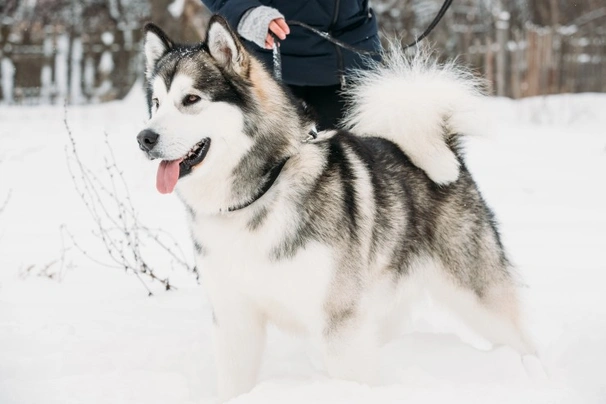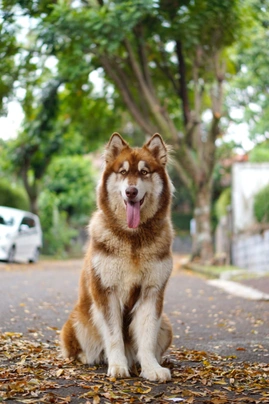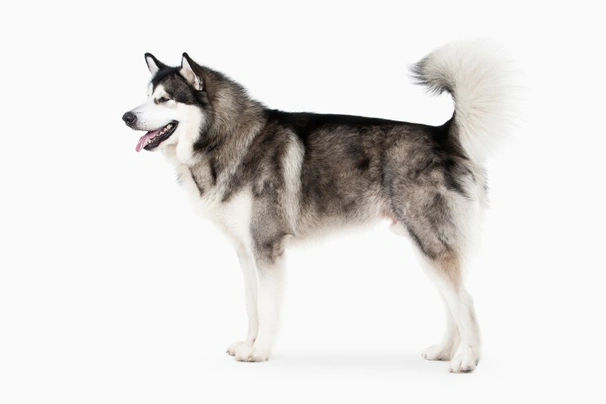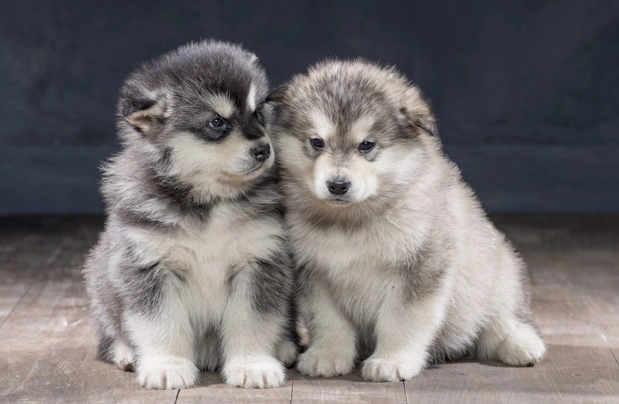Alaskan Malamute
Pros
Cons
Introduction of the Alaskan Malamute
The Alaskan Malamute is often mistaken for a Husky but they are larger than most of the other "Spitz" type dogs and this includes the Husky. Malamutes are heavy well-boned dogs that were originally bred by the Mahlemuts an Inuit tribe to pull heavy sledges through the snow in some of the harshest conditions of the Artic of western Alaska.
Today Malamutes have become a popular choice with people both in the UK and elsewhere in the world thanks to their unique wild looks and kind personalities. They are dominant characters by nature and need to be handled and trained from a young age by experienced dog owners who are familiar with their specific needs. In short a Malamute is not the best choice of dogs for first-time owners. These dogs need to know their place in the pack and who is the Alpha Dog. They are intelligent but they are not generally very quick to respond to commands which is something to bear in mind during their training.
History of the Alaskan Malamute
The Alaskan Malamute has a fascinating ancestry and it is thought they have ancient dogs in their lineage which includes those associated with prehistoric man who migrated across the Arctic on his journey to Greenland which occurred over thousands of years. The result was that dogs evolved naturally with some having long coats and others having shorter coats depending on the regions they were found. Some evolved into longer legged dogs which today can be found in Canada's lakes and forests.
Malamutes are native to Alaska as their name suggests. They were bred by an Inuit tribe called Mahlemuts to pull sledges and being highly skilled hunters they helped their masters track down food dogs creating an inter-dependence between dog and man. These dogs were bred to be resilient and strong enough to cope with the harshest Artic climate and they share the same ancestry as other dogs from artic regions of the world namely the Eskimo dogs of Greenland the Labrador the Siberian Husky and the Russian Samoyed. However these dogs were kinder natured than many others found in different regions a trait that was noted by explorers of the day.
During the 1890's Klondike Gold Rush the Malamute and other sled dogs became extremely valuable to recently landed prospectors and settlers who frequently crossbred them with imported breeds with the end goal being to improve the breed and to make up the numbers of dogs available because true Alaskan Malamutes were few and far between at the time. This cross-breeding almost led to the true breed nearly vanishing altogether but the Inuit tribes continued to breed pure bred Malamutes and later American enthusiasts ensured these dignified proud looking dogs did not disappear off the face of the planet for good.
The Mahlamutes bred these dogs to be powerful and strong rather than for their speed and they looked and cared for them which insured both the people and their dogs prospered and thrived. The breed was discovered by settlers during the mid-1800s and there are those who believe that Alaskan Malamutes were used on Peary Cook and Byrd's expedition to the North Pole in 1909.
It was Malamutes that were bred in the Chinook Kennels owned by Arthur T Walden and later by the Seeleys that were used by Byrd on his expedition in the thirties and it was through their endeavours that dogs similar to those that existed in the Norton Sounds area were reproduced and which were to become known as the Kotzebue strain.
Paul Voelker Senior and his son developed a strain that was slightly different by using dogs they imported from Alaska during the early 1900's and then again other dogs they introduced in the twenties which were known as the M'Loot strain having been given the name after the Voelker kennels. During the two World Wars some of the dogs were used in service and again for another of Byrd's expeditions.
Recent DNA analysis shows that the Malamute is one of the oldest breeds of dog on the planet. It was only in 1935 that the breed was officially recognised by the American Kennel Club and they were accepted by The Kennel Club here in the UK a little later in time. In 2010 the breed was named as being Alaska's official state dog. Today the Kotzebue and the M'Loot remain terms used in an Alaskan Malamute's genetic lineage whether they are similar to their ancestors or not.
Interesting facts about the breed
- Is the Alaskan Malamute a vulnerable breed? No they are one of the most popular dogs both in the UK and elsewhere in the world
- Alaskan Malamutes do not have blue eyes. Their eyes range from a light to dark brown and amber in colour depending on their coat colour
- Malamutes have an extremely high prey drive and will take off after smaller animals and dogs if they get the chance so they need to be kept on their leads in public places to be on the safe side
- Alaskan Malamutes get on with other female dogs but can be aggressive and dominant towards other male dogs
- Malamutes shed copious amounts of fur all year long and more especially during the Spring and then again in the Autumn
Appearance of the Alaskan Malamute
Height at the withers: Males 64 - 71 cm Females 58 - 66 cm
Average Weight: Males 38 - 56 kg Females 38 - 56 kg
The Alaskan Malamute is a big powerful and handsome dog. They are heavily boned which adds to their overall impressive appearance. Malamutes boast large broad heads with a large muzzle that's as wide as their skulls. They have almond-shaped brown medium sized eyes although lighter coated dogs have lighter coloured eyes which is acceptable as a breed standard.
Their ears are small in relation to their heads and are triangular shaped with tips that are slightly rounded. They are set wide apart on a dog's head. Malamutes have strong upper and lower jaws with a perfect scissor bite. Their necks are extremely powerful which dogs hold slightly arched.
Their shoulders are well-boned and solid with well-muscled front legs and their bodies are powerful very muscled with a deep check and straight back that slopes down from their shoulder to their croup. Hindquarters are extremely well-muscled and powerful looking with strong well-developed back legs that are a good indication of a Malamute’s strength. Their feet are large and well-rounded with closed toes and well-arched pads.
Malamutes have thickly furred tails that are set high and which curves upwards ever so slightly. When at rest these dogs hold their tails down but they carry their tail over their backs when they are being put through their paces.
When it comes to their coat the Malamute boasts an extremely thick and coarse outer guard coat that's soft and never too long. They have a very dense undercoat which is both woolly and oily being anything from 2.5 to 5 cm deep and which offers tremendous protection from the elements. Their guard coat and undercoat can vary in length being thicker around a dog's shoulders and neck as well as down the back and over the croup. The hair forms breeching on a dog's legs too.
Malamutes boast a variety of colours but the accepted Kennel Club colours for registration are as follows:
- Agouti & White
- Black & White
- Blue & White
- Grey & White
- Red & White
- Sable & White
- Seal & White
- Silver & White
- White
- Wolf Grey & White
- Wolf Sable & White
Whatever colour a Malamute is they always have white on their underbodies on different areas of their legs and on part of their masks. The markings on their faces can either be mask-like or cap-like with some dogs having a combination of both which is acceptable as a breed standard. Dogs can also have a white blaze on their foreheads and a white collar as well as a white spot on their napes.
Gait/movement
When an Alaskan Malamute moves they do so freely with a tireless and easy gait that's extremely rhythmic. They have a tremendous amount of drive from their hindquarters and cover a lot of ground with every stride.
Faults
The Kennel Club frowns on any exaggerations and departures from the breed standard and would judge any faults on how much they affect a dog's overall health and wellbeing as well as their ability to perform.
Males should have both testicles fully descended into their scrotums and it is worth noting that the size and weight of an Alaskan Malamute can vary with dogs being a little taller or shorter as well as slightly heavier or lighter than given in their Kennel Club breed standard which is given as a guideline only.
Temperament of the Alaskan Malamute
The Alaskan Malamute is an intelligent dog although they can be slow when responding to commands. Although large and impressive looking these dogs are extremely friendly by nature and as such they are not known to be good watchdogs more especially as they seldom make a sound or bark except for a noise of their own.
They need to be well-socialised and introduced to as many new people animals and situations as possible early in their lives to be truly well-rounded dogs. They need to be handled firmly yet gently by someone who is an experienced dog owner. As such they are not the best choice for first time dog owners because the Malamute needs to know their place in the "pack" and who is the Alpha Dog in a household. The ideal owner would already be familiar with this type of dog because the breed is known to be a very independent and self-reliant character by nature.
They are also extremely good escape artists which means back gardens must be extremely secure bearing in mind that Malamutes are excellent “diggers” and will happily tunnel their way out of a garden should they want to. As such many owners do not trust their Malamutes enough to leave them outside in a garden on their own and unsupervised.
Are they a good choice for first time owners?
Alaskan Malamutes are not the best choice for first time dog owners and are better suited to people who are familiar with their specific needs and who know how to train and socialise them correctly so they are better behaved dogs. Malamutes can be strong willed and having an independent streak in them need to be handled with a firm yet gentle hand and their training not only has to be consistent but also continuous throughout a dog’s life bearing in mind that a Malamute would always be ready to test the limits and boundaries that were set for them by an owner.
What about prey drive?
Malamutes have a very high prey drive and would be quick off the mark when it comes to chasing any animals that come into their sights. As such great care should always be taken as to where and when a Malamute can run free off their leads with most owners preferring not to let a dog off the lead in a public place just to be on the safe side.
What about playfulness?
Alaskan Malamutes are playful by nature and some dogs excel at many canine sporting activities which includes things like agility weight pulling rallying cani-cross and backpacking. They remain very playful throughout their lives and enjoy being entertained and entertaining their owners with their outgoing playful and very comical personalities.
What about adaptability?
Alaskan Malamutes are better suited to people who have extremely secure back gardens where dogs can safely run around without the risk of them escaping. They are not the best choice for anyone who lives in an apartment because these dogs need to be given a lot of vigorous exercise and mental stimulation to keep them happy and occupied.
What about separation anxiety?
Alaskan Malamutes are fiercely loyal and devoted to their owners and hate it when they are left on their own for any length of time. As such they are better suited to households where one person stays at home when everyone else is out to prevent a Malamute from suffering from separation anxiety. This could lead to a dog being destructive around the home which is their way of entertaining themselves and relieving the stress they are experiencing.
What about excessive barking?
Malamutes are not like many other breeds being much quieter but with this said they do have a language of their own and when there are two or more of them in a household they often take to howling with all of them starting and ending their chorus at the same time.
Do Alaskan Malamutes like water?
Most Malamutes are not that keen on being in water and will avoid even getting their feet wet. With this said a dog that does not enjoy swimming should never be forced into the water because it would just end up frightening them. Others will go swimming when they weather is hot.
Are Malamutes good watchdogs?
Alaskan Malamutes are not the best guard dogs because they tend to greet everyone they meet as a friend. With this said a Malamute would be quick to let an owner know when there are strangers about or when something is happening in their surroundings that makes them nervous.
Intelligence / Trainability of the Alaskan Malamute
Alaskan Malamutes are known to be a more dominant breed and therefore their training and socialisation must start as early as possible for them to become well-rounded obedient dogs. They are intelligent and with the right sort of handling training and direction an Alaskan Malamute responds and learns new things well. However they do not respond that quickly to any commands they are given which must be taken into account when they are being trained.
They respond well to positive reinforcement but it takes time and patience as well as a lot of understanding of the breed to successfully train a Malamute which is why they are better suited to people who are familiar with their needs and who have the time to dedicated to an intelligent albeit quite independent thinking canine companion.
It's essential for these dogs to know their place in the "pack" and who is the alpha dog in a household or they will take over and show the more dominant side to their characters. Once a Malamute understands what is expected of them they will respond well but would always test the boundaries whenever they can. Puppies should be taught the basic commands right from the word go which includes the following:
- Come
- Sit
- Stay
- Quiet
- Leave it
- Down
- Bed
Children and other
Malamutes have a heightened prey drive so while Malamutes are in general amiable around people and can be taught to tolerate other pets you have to be careful with them when they are around smaller animals and toddlers though just to be on the safe side. In short it's best to always keep a close eye on children when they are around a Malamute to make sure things stay calm and that nobody gets over excited which could result in a child getting knocked over hurt or scared.
As such Pets4homes advises that Alaskan Malamutes are not the best choice for families with babies or very young children. Anyone who already shares a home with a Malamute and who have younger children should always make sure they are never left together unattended. It is also crucial for parents to teach young children how to behave around dogs and when to stay away from them particularly when there is food around or during playtime.
If a Malamute is introduced to other animals and pets from an early age they will generally accept them although care should always be taken because they have retained a very strong hunting instinct. A Malamute would see smaller animals and pets as "fair game" which could end in a disaster.
Health of the Alaskan Malamute
The average life expectancy of an Alaskan Malamute is between 10 to 12 years when properly cared for and fed an appropriate good quality diet to suit their ages.
As with many other pure breeds the Malamute is known to suffer from certain hereditary and acquired health issues which are worth knowing about if you are hoping to share your home with one of these impressive looking dogs. The health problems most commonly seen in the breed are as follows:
- Hip Dysplasia (HD) - test available through BVA/KC
- Eye Disorders including hereditary cataracts - test available through BVA/KC
- Cone Degeneration (CD) - DNA screening available via a blood sample or a buccal swab
- Alaskan Malamute Polyneuropathy (AMPN) - DNA screening available
- Epilepsy
- Gastric torsion/bloat
- Chondrodysplasia (dwarfism) - puppies between the ages of 5 and 12 weeks can be x-rayed to see if their front limbs are deformed
- Coat funk/alopecia X
More about coat funk/alopecia X
Malamutes can suffer from a condition known as coat funk or alopecia X which is thought to be a hereditary skin disorder. With this said more research is needed to establish the mode of inheritance and as such any dog affected should not be used for breeding purposes. Some people believe breeders should wait until a dog is over the age of 5 before being used in a breeding programme although this is quite controversial.
The condition goes by other names which includes Black Skin Disease or Folliclular dysplasia to name but two more and the condition appears to affect breeds with thick dense double coats like that of the Alaskan Malamute. It is also thought to be an endocrine disorder and studies have suggested that it could be because dogs produce too much cortisol which is a steroid hormone in their systems. The symptoms include the following:
- Abnormal shedding leaving a coat looking dry and dull
- Guard hairs turn brittle and dry more especially around a dog's neck tail and breeches
- Bald patches appear around a dog's tail gland rear haunches body and neck leaving the skin looking black
Alopecia X seems to affect males more than their female counterparts and more especially before they are 5 years of age.
More about epilepsy
When a dog experiences a seizure or convulsions and vets cannot find out the causes their condition is referred to as them suffering from Idiopathic epilepsy or generalised primary epilepsy and it is thought that the disorder could well be inherited. Research has established that around 6% of dogs no matter what their breed can suffer from idiopathic epilepsy although the condition is more prevalent in certain breeds than in others. However there are other reasons why a dog might suffer from an episode and this includes because they are suffering or have developed the following conditions:
- Brain tumours - which are more commonly seen in dogs over the age of 5
- Injury to the head
- Strokes
- Low blood sugar - a condition known as hypoglycaemia
- Low blood oxygen - a condition known as hypoxaemia
- Liver disease/infection
- Infectious or inflammatory disease of a dog's nervous system
- Toxins - when a dog ingests any toxins which includes pesticides they can suffer from an episode
- Botulism - bacteria in food
- Parasites - an over burden of intestinal parasites can be the cause of an episode
- Low magnesium or low serum calcium levels
- Imbalances in blood sodium or potassium levels
- Kidney failure
- Hyperthermia
- Thyroid hormone deficiency - a condition known as hypothyroidism
- Hyperactive thyroid - a condition known as hyperthyroidism
More about the long coat gene
A test is available to establish if a Malamute has the "long-coat" gene and all responsible breeders would have their stud dogs tested before using them in a breeding programme to establish whether they do. The condition is known to have an autosomal recessive mode of inheritance and the test would only establish if a dog is affected a carrier or clear and will not establish any modifiers in a dog's coat.
It is worth noting however that Malamutes that carry the Long Coat gene often have much better "bone" and substance about them.
What about vaccinations?
Malamute puppies would have been given their initial vaccinations before being sold but it is up to their owners to make sure they have their follow-up shots on time with the vaccination schedule being as follows:
- 10 -12 weeks old bearing in mind that a puppy would not have full protection straight away but would be fully protected 2 weeks after they have had their second vaccination
There has been a lot of discussion about the need for dogs to have boosters. As such it's best to talk to a vet before making a final decision on whether a dog should continue to have annual vaccinations which are known as boosters.
What about spaying and neutering?
A lot of vets prefer to wait until a Malamute is anything between the ages of 6 to 9 months old before spaying or neutering them. The reason being that dogs are slightly more mature before having to undergo the procedures. However other vets recommend spaying and neutering dogs when they are 6 months old but never any younger unless there are medical reasons for doing so.
What about obesity problems?
Most Malamutes do not have a problem with their weight because they are so energetic and active by nature. With this said some dogs can gain weight after they have been spayed or neutered and when they reach their golden years which is when it's important to keep an eye on their weight and to adjust their calorie intake accordingly. Obesity can seriously and negatively impact a dog's overall health and wellbeing shortening their lives by several years.
What about allergies?
As previously mentioned the Alaskan Malamute is predisposed to suffering from Alopecia X and if there is a flare up it's important for a dog to be examined by a vet sooner rather than later before the condition gets too bad and therefore harder to treat and clear up.
Participating in health schemes
All responsible breeders would ensure their stud dogs are tested for any known hereditary or congenital health issues before using them in a breeding programme. As such they would use the following tests and schemes to reduce the risk of puppies inheriting the disorders:
- BVA/KC Hip Dysplasia Scheme
- BVA/KC Eye Scheme
- Alaskan Malamute Polyneuropathy (AMPN) - DNA screening available
- Cone Degeneration (CD) - DNA screening available
- Chondrodysplasia (dwarfism) - puppies when they are between the ages of 5 and 12 weeks can be x-rayed to see if their front limbs are deformed
More about Alaskan Malamute Polyneuropathy (AMPN)
Alaskan Malamute Polyneuropathy or AMPN is a condition that's also known as hereditary polyneuropathy idiopathic polyneuropathy of Alaskan Malamute (IPAM). The condition negatively impacts a dog's peripheric nervous system which then leads to nerve degeneration. Eventually a dog's muscles degrade over a period of time because they do not receive the necessary stimulation they should to remain healthy.
A lot of research is being carried out into why the mutation exists in the Alaskan Malamute but it is known to be an autosomal recessive disease and that symptoms first present themselves during the first 2 years of a Malamute's life with dogs falling over for no apparent reason or walking on the top of their feet with their gait being slightly off. As the condition progresses it may affect a dog's larynx which can make it hard for them to swallow and their barks often change too.
More about Cone Degeneration (CD)
Cone degeneration or CD is another autosomal recessive disease that appears to affect certain breeds more than others with the Alaskan Malamute being one of them. The condition causes day-blindness because the cone function found in a dog's retina is absent. Dogs first start showing signs of there being something wrong with their vision when they are anything from 8 to 12 weeks old which is when they retinas are fully formed.
Alaskan Malamutes should be tested for CD before being used in a breeding programme to reduce the risk of puppies inheriting the disorder from their parents.
What about breed specific breeding restrictions?
Apart from the standard breeding restrictions set in place by the Kennel Club for all recognised breeds currently there are no further breed specific breeding restrictions in place for the Alaskan Malamute.
What about Assured Breeder Requirements?
It is mandatory for all Kennel Club Assured Breeders to have their stud dogs tested for the following known conditions and the Kennel Club strongly advises that all other breeders follow suit:
The Kennel Club also strongly advises that all breeders use the following schemes before using an Alaskan Malamute for breeding purposes:
- Bitches should not be mated before their third season
- Bitches should not produce a litter of puppies when they are under the age of 2
- Bitches should not produce more than 1 litter within a 12-month period
- DNA test - AMPN
- DNA test - Cone degeneration
Caring for the Alaskan Malamute
As with any other breed Alaskan Malamutes need to be groomed on a regular basis to make sure their coats and skin are kept in tip-top condition bearing in mind that the breed is known to be predisposed to a condition known as Alopecia X. They also need to be given regular daily exercise so they remain fit and healthy. On top of this Malamutes need to be fed good quality food that meets all their nutritional needs throughout their lives.
Caring for aMalamute puppy
Getting a puppy is an exciting experience but it's also a big decision because sharing a home with a dog is a lifelong commitment. The timing of when a puppy is introduced to their new environments also takes careful planning and it's best to organise this when someone is going to be around for at least the first week or so. No matter how outgoing a puppy tends to be they would be feeling quite vulnerable having just left mum and their littermates. In short they need to know they are not alone in a strange environment which could stress them out even more.
Puppies are notorious for chewing on things some of which they are given whereas others are things they find lying around the home. As such puppy-proofing the home and the garden is essential and it should be done well in advance of their arrival. Electric wires and cables should be put out of harm's way and anything breakable be put somewhere safe to avoid breakages. Garden tools and implements should not be left out because a boisterous playful puppy might injure themselves on them.
Investing in stairgates to fit on doors helps limit the amount of space a puppy can roam around in which keeps them safer too. Another option is to buy a well-made playpen which also keeps young puppies safely out of harm's way and the risk of stepping or tripping over them is eliminated altogether. Puppies also need to sleep a lot which can be anything up to 21 hours a day so they need a nice quiet area they can retreat to when they want to nap. The area should not be too out of the way because puppies need to know someone is around and it's also important to be able to keep an ear out for them should they get themselves into any sort of trouble.
The documentation a breeder provides for a puppy must have all the details of their worming date and the product used as well as the information relating to their microchip. It is essential for puppies to be wormed again keeping to a schedule which is as follows:
- Puppies should be wormed at 6 months old
- They need to be wormed again when they are 8 months old
- Puppies should be wormed when they are 10 months old
- They need to be wormed when they are 12 months old
Things you'll need for your puppy
There are certain items that new owners need to already have in the home prior to bringing a new puppy home. It's often a good idea to restrict how much space a puppy plays in more especially when you can't keep an eye on what they get up to bearing in mind that puppies are often quite boisterous which means investing in puppy gates or a large enough playpen that allows a Malamute puppy the room to express themselves while keeping them safe too. The items needed are therefore as follows:
- Good quality puppy or baby gates to fit on doors
- A good well-made playpen that's large enough for a Malamute puppy to play in so they can really express themselves as puppies like to do
- Lots of well-made toys which must include good quality chews suitable for puppies to gnaw on bearing in mind that a puppy will start teething anything from when they are 3 to 8 months old
- Good quality feed and water bowls which ideally should be ceramic rather than plastic or metal
- A grooming glove
- A slicker brush or soft bristle brush
- Dog specific toothpaste and a toothbrush
- Scissors with rounded ends
- Nail clippers
- Puppy shampoo and conditioner which must be specifically formulated for use on dogs
- A well-made dog collar or harness
- A couple of strong dog leads
- A well-made dog bed that's not too small or too big
- A well-made dog crate for use in the car and in the home that's large enough for a Malamute puppy to move around in
- Baby blankets to put in your Malamute's crate and in their beds for when they want to nap or go to sleep at night
Keeping the noise down
All puppies are sensitive to noise including Malamute puppies. It's important to keep the noise levels down when a new puppy arrives in the home. TVs and music should not be played too loud which could end up stressing a small puppy out.
Keeping vet appointments
As previously touched upon all puppies would have been given their first vaccinations before being sold but it's essential they have their follow-up shots on time. The vaccination schedule for puppies is as follows:
- 10 -12 weeks old bearing in mind that a puppy would not have full protection straight away but would only be fully protected 2 weeks after they have had their second vaccination
When it comes to boosters it's best to discuss these with a vet because there is a lot of debate about whether a dog really needs them after a certain time. However if a dog ever needed to go into kennels their vaccinations would need to be
What about older Malamutes when they reach their senior years?
Alaskan Malamutes need lots of special care because as they reach their golden years they are more at risk of developing certain health concerns. Physically a Malamute will start to have a greying muzzle but there will be other noticeable changes too which includes the following:
- Coats become coarser
- A loss of muscle tone
- Malamutes can either become overweight or underweight
- They have reduced strength and stamina
- Older dogs have difficulty regulating their body temperature
- They often develop arthritis
- Immune systems do not work as efficiently as they once did which means dogs are more susceptible to infections
Older dogs change mentally too which means their response time tends to be slower as such they develop the following:
- They respond less to external stimuli due to impaired vision or hearing
- They tend to be a little pickier about their food
- They have a lower pain threshold
- Become intolerant of any change
- Often an older dog can feel disorientated
Living with a Malamute in their golden years means taking on a few more responsibilities but these are easily managed and should include rethinking their diet the amount of exercise they are given how often their dog beds need changing and keeping an eye on the condition of their teeth.
Older Malamutes need to be fed a good quality diet that meets their needs at this stage of their lives all the while keeping a close eye on a dog's weight. A rough feeding guide for older Malamutes is as follows bearing in mind they should be fed highly digestible food that does not contain any additives:
- Protein content should be anything from 14 – 21%
- Fat content should be less than 10%
- Fibre content should be less than 4%
- Calcium content should be 0.5 – 0.8%
- Phosphorous content should be 0.4 – 0.7%
- Sodium content should be 0.2 – 0.4%
Older Malamutes don't need to be given the same amount of daily exercise as a younger dog but they still need the right amount of physical activity to maintain muscle tone and to prevent a dog from putting on too much weight. All dogs need access to fresh clean water and this is especially true of older dogs when they reach their golden years because they are more at risk of developing kidney disorders.
Grooming of the Alaskan Malamute
Malamutes have very thick coats and are therefore high maintenance in the grooming department. They need daily brushing to keep their coats looking good and any shed hair under control. They are heavy shedders which like other breeds tends to happen more in the Spring and then again in the Autumn when Malamutes need even more grooming. It pays to get a Malamute professionally groomed at least 2 to 3 times a year because it makes keeping their coats tidy that much easier in between their visits to a grooming parlour.
Malamutes don't need to be bathed too frequently and if they do it's best to leave this up to a professional groomer who would be able to make sure a dog's coat is thoroughly dried after they've been bathed.
Exercise of the Alaskan Malamute
Malamutes need to be given a lot of daily exercise and ideally this needs to be for at least 1 hour twice a day. If possible these dogs love to run free so they can really let of steam but you should only let a Malamute off their leads in a place where it is safe to do and where there's no risk of them running off and worrying any other animals and livestock.
These days there are lots of sledging clubs dotted around the country which are a great place to take a Malamute so they get to do what they were originally bred to do - namely pull a sledge.
Feeding of the Alaskan Malamute
Alaskan Malamutes are large dogs and therefore the cost of feeding one is higher than smaller breeds and other large dogs. If you decide to get a Malamute puppy it's important for them to stay on the diet they are used to otherwise they might end up with a tummy upset. Breeders normally give new owners a feeding schedule for their puppies and it's essential these be kept to and to feed puppies the same food. You can change their diet but this needs to be done gradually when the time is right.
Although not known to be fussy eaters you should not feed an Alaskan Malamute lower quality dog food because it would not contain the right levels of nutrients to meet a dog's daily requirements which could result in them developing damaging deficiencies in minerals vitamins and other valuable nutrients that dogs need to remain healthy.
Feeding guide for an Alaskan Malamute puppy
Puppies need to be fed a highly nutritious good quality diet for them to develop and grow as they should. As a rough guide a Malamute puppy can be fed the following amounts every day making sure their meals are evenly spread out throughout the day and it's best to feed them 3 or 4 times a day:
- 2 months old - 298g to 329g depending on puppy's build
- 3 months old - 386g to 417g depending on puppy's build
- 4 months old - 425g to 456g depending on puppy's build
- 5 months old - 495g to 526g depending on puppy's build
- 6 months old - 557g to 558g depending on puppy's build
- 7 months old - 559g to 590g depending on puppy's build
- 8 months old - 524g to 555g depending on puppy's build
- 9 months old - 491g to 526g depending on puppy's build
- 10 months old - 458g to 489g depending on puppy's build
- 11 months old - 429g to 460g depending on puppy's build
- 12 months old - 402g to 433g depending on puppy's build
- 13 months old - 399g to 430g depending on puppy's build
- 14 months old - 395g to 426g depending on puppy's build
Once a puppy is 15 months old they can be fed adult dog food.
Feeding guide for an adult Alaskan Malamute
Once fully mature an adult Malamute must be fed a good quality diet to ensure their continued good health. As a rough guide an adult Malamute can be fed the following amounts every day:
- Dogs weighing 38 kg can be fed 366g to 482g depending on activity
- Dogs weighing 40 kg can be fed 381g to 501g depending on activity
- Dogs weighing 45 kg can be fed 409g to 538g depending on activity
- Dogs weighing 50 kg can be fed 437g to 575g depending on activity
- Dogs weighing 56 kg can be fed 465g to 612g depending on activity
Alaskan Malamute price
If you are looking to buy an Alaskan Malamute you would need to be prepared to pay anything from £250 to well over £800 for a well-bred pedigree puppy. The cost of insuring a male 3-year old Alaskan Malamute in northern England would be £20.04 a month for basic cover but for a lifetime policy this would set you back £47.19 a month (quote as of September 2107). When insurance companies calculate pet insurance they factor in a few things and this includes where you live in the UK and a dog's age and breed as well as whether a dog is spayed or neutered.
When it comes to food costs you need to buy the best quality food whether wet or dry to feed your dog throughout their lives making sure it suits the different stages of their lives. This would set you back between £40 -£60 a month. On top of this you would need to factor in veterinary costs if you want to share your home with a Malamute which includes their initial vaccinations their boosters the cost of neutering or spaying your dog when the time is right and then their annual health check visits all of which could quickly add up to well over a £800 a year.
As a rough guide the average cost to keep and care for a Malamute would be between £80 to £120 a month depending on the level of insurance cover you opt to buy for your dog but this does not include the initial cost of buying a well-bred pedigree Kennel Club registered Alaskan Malamute puppy.
Buying advice
When visiting and buying any puppy or dog there are many important things to consider and questions to ask of the breeder/seller. You can read our generic puppy/dog advice here which includes making sure you see the puppy with its mother and to verify that the dog has been wormed and microchipped.
Malamutes are an extremely popular breed both in the UK and elsewhere in the world which means that well-bred puppies command a lot of money. As such with Malamutes there is specific advice questions and protocols to follow when buying a puppy which are as follows:
- Beware of online scams and how to avoid them. You may see online and other adverts by scammers showing images of beautiful Alaskan Malamute puppies for sale at very low prices. However the sellers ask buyers for money up front before agreeing to deliver a puppy to a new home. Potential buyers should never buy a puppy unseen and should never pay a deposit or any other money online to a seller. You should always visit the pet at the sellers home to confirm they are genuine and make a note of their address.
- As previously touched upon Malamutes are among the most popular breeds in the UK. As such there are many amateur breeders/people who breed from Malamutes far too often so they can make a quick profit without caring for the welfare of the puppies their dam or the breed in general. Under Kennel Club rules a dam can only produce 4 litters and she must be between a certain age to do so. Anyone wishing to buy a Malamute puppy should think very carefully about who they purchase their puppy from and should always ask to see the relevant paperwork pertaining to a puppy's lineage their vaccinations and their microchipping
- Prospective Alaskan Malamute owners should be aware that the breed never has blue eyes and if they do it is because they have been more than likely crossed with a Siberian Husky or have Siberian Husky in their ancestry

9 month old male alaskan malamute
£1,000
Alaskan Malamute puppies only 1 boy remaining
£1,400
